How can you replace potatoes during a diet
"In Russia, without potatoes - like a party without an accordion", "Potatoes - the second bread" - these sayings from the past, but even today our people do not betray their favorite product. There are many useful substances in potatoes, but its constant use in food leads to weight gain and, as a result, to serious diseases. However, there are natural products that resemble potatoes in taste and method of preparation, which also bring great benefits to the body.
How can you replace potatoes during a diet - read on.
The content of the article
Chemical composition, trace elements and nutritional value of potatoes

Among the main vitamins that the tuber is rich in:
- C - 100 g of product contains up to 28% of the daily value;
- B6 - 27%.
However, during the cooking process, their number decreases.
Trace elements:
- Potassium - 19%. Reduces the risk of cardiovascular diseases, normalizes oxygen exchange.
- Manganese - 26% Enhances the action of insulin, participates in the production of thyroid hormones.
- Chromium - 20%. Regulates carbon and fat metabolism. Its deficiency causes sugar cravings.
- Magnesium - 12% "Mineral of the heart". Participates in the formation of new cells and strengthening the nervous system.
In addition, the composition contains omega-3 fatty acids - 0.1 g (10%), as well as dietary fiber - 1.4 g (7%).
Calorie content, BZHU, glycemic index of potatoes
The calorie content of potatoes is 77 kcal (per 100 g of raw product), which is 5% of the average daily intake. This indicator changes depending on the cooking method:
100 g of the product contains:
- Protein 2 g (2% DV)
- fats - 0.4 g (0.6%);
- carbohydrates - 16.3 g (12.0%).
Carbohydrates are mainly represented starchfor which potatoes have a bad reputation.
What is harmful and useful starch

Potatoes are high in carbohydrates in the form of starch (12% of the daily value in 100 g). Because of this nutrient, WHO does not include potatoes among healthy natural foods. It is believed that the conversion of starch to glucose in the body leads to obesity, heart attack, stroke, type 2 diabetes.
However, on closer examination, the situation looks more optimistic:
- Some part of the starch after heat treatment turns into stable (resistant), i.e. insoluble in the stomach. In the large intestine, it nourishes bacteria that convert it into saturated fatty acids (butyric acid) that reduce inflammation, protect the intestinal wall, and are associated with a lower risk of colorectal cancer.
- Resistant starch, unlike regular starch, lowers blood glucose levels.
- Both resistant starch and soluble fiber keep you feeling full and prevent overeating.
Unfortunately, there is little resistant starch in boiled potatoes - only 3.2%, which is four times less than usual.
The glycemic index (GI) signals the amount of glucose formed in the blood two hours after eating a product. For this indicator, products are divided into three groups:
- with a low GI value - 0-55;
- with an average - 56-69;
- with high - 70 and above.
The change in blood sugar level 2 hours after the consumption of glucose is taken as 100.
The glycemic index of potatoes varies depending on how the dish is prepared:
- potato puree – 90;
- chips - 80;
- cooked in a uniform - 65.
So, potatoes contain few calories and fats, but a lot of carbohydrates, mostly simple ones with a high GI, thanks to which the vegetable is not recommended for people who are overweight or have diabetes.
However, properly cooked potatoes (either skins-boiled or oven-baked with the skin) without oil can be a dietary staple, especially when combined with low-carb foods (such as meat with a small portion of baked potatoes and salad). The main thing is not to eat a lot of tubers and, if possible, replace with other products.
Important! It is necessary to take into account the individual glycemic response to potatoes. It is helpful to have a meter and find out your response to food intake.
How can you replace potatoes in soup, Olivier, vinaigrette and other dishes when dieting?
There are natural products that are close to potatoes in terms of taste and types of dishes that can be prepared from them.
Celery

Consume stems, root and leaves.
Calorie content is 6 times less than that of potatoes; carbohydrates 8 times, and fats - 4 times less, but contains the same amount of fiber. There are only 0.9 g of proteins in 100 g of the product. The glycemic index is 15.
Celery rich in vitamins:
- And (83% of the daily value in 100 g) improves vision and skin, supports immunity, is responsible for reproductive function;
- C (43%) strengthens the immune system, promotes the absorption of iron, participates in redox reactions.
In addition, celery has a high sodium content, which has a beneficial effect on kidney and bladder function. The plant has a diuretic effect.
Attention! Contraindications to the use of celery in large quantities are urolithiasis and thrombophlebitis.
Celery tubers are fried like potatoes in a small amount of olive oil with chopped onions, added to the soup. Salads are prepared from stems and leaves.
Low calorie content and low carbohydrate content are the basis for the use of this vegetable in a diet for weight loss.
Daikon, or Japanese (Chinese) radish
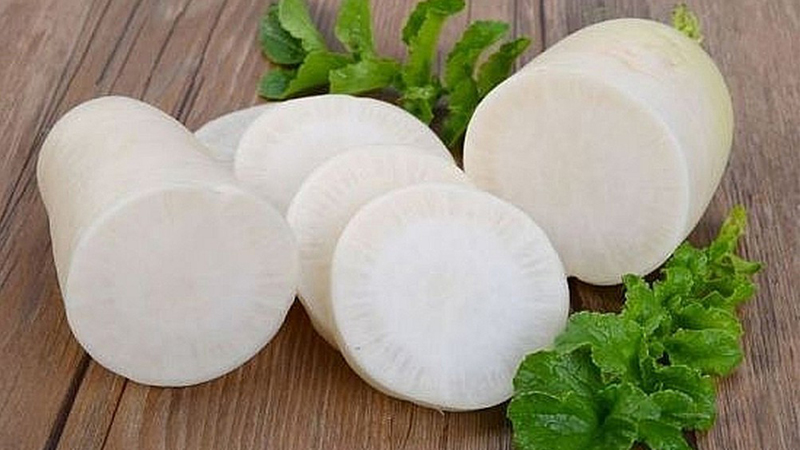
Root vegetable, a subspecies of radish.
Caloric content is 3 times less than that of potatoes; contains less carbohydrates - 8 times, proteins - 2 times, fats - 2 times. The amount of dietary fiber is the same. GI - 15.
Most of all, the root vegetable contains:
- vitamin C - 22% of the daily value;
- copper - 12% (it participates in the processes of assimilation of proteins, saturation of cells with oxygen).
Daikon tastes like a radish or radish, but without bitterness. Used primarily raw in salads.
Due to its low carbohydrate content and low calorie content, it is used in dietary nutrition.
Swede
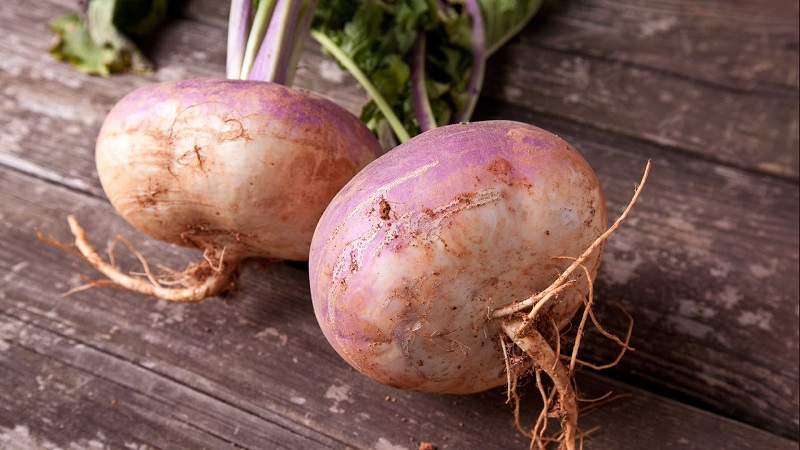
Calorie content - only 37 kcal. The glycemic index is 99. 100 g of the product contains:
- proteins - 1.2 g;
- fats - 0.1 g:
- carbohydrates - 7.7 g;
- dietary fiber - 2.1 g
Differs in a high content of vitamin C (33%), which is not destroyed during winter storage and cooking.
Rutabaga can be boiled, fried, stewed. But it is better to add it to other vegetables in a stew. Salads are made from the tops. In late winter and early spring, it continues to supply the body with vitamins, unlike other vegetables.
The high GI does not allow the use of rutabagas as a weight loss product.
Turnip

Calorie content and BZHU are similar to swede. The glycemic index is 15 for raw and 85 for boiled.
Turnip is useful:
- vitamin C - 22% of the daily value in 100 g of the product;
- silicon - 303% (stimulates collagen synthesis);
- cobalt - 20% (part of vitamin B12, activates fatty acid metabolism enzymes).
The root vegetable is used in salads, hot meat dishes, soups. Turnips are fried, pickled, baked. This is a good dietary product.
Kohlrabi
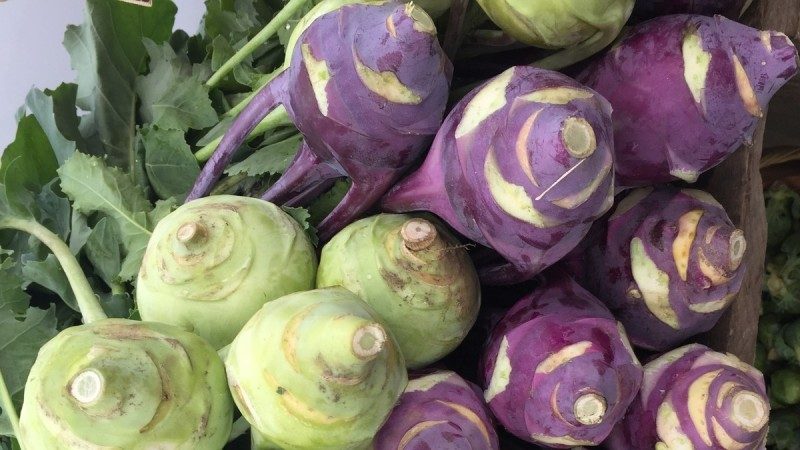
A kind of white cabbage. But, unlike her, not the leaves are used for food, but the lower spherical part of the stem - the stem crop.
Calorie content - 42 kcal. The glycemic index is 15.
100 g of the product contains:
- proteins - 2.8 g;
- fats - 0.0 g;
- carbohydrates - 10.7 g;
- dietary fiber - 1.7.
Kohlrabi is a champion in vitamin C content - 56% of the daily dose in 100 g of the product. "Northern lemon" is another name for this vegetable.
Cabbage contains a lot of potassium (15%) and silicon (237%).
Vegetables are stewed, fried, boiled, pickled, salads are prepared.
Kohlrabi is considered a valuable dietary product due to its low fat and carbohydrate content and low GI.
Jerusalem artichoke, or earthen pear
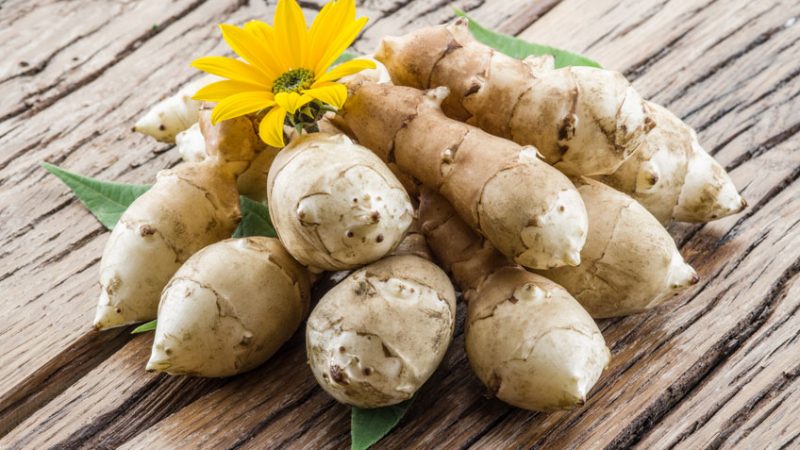
Another analogue. It is similar in composition to potatoes, but contains three times more fiber. The glycemic index is 14.
Jerusalem artichoke is rich in silicon - 26% of the daily dose in 100 g of the product.
Most other vegetables contain the probiotic inulin (from 16 to 18%), which serves as a medium for lactobacilli and bifidobacteria and helps the body to get rid of cholesterol.
It tastes like a cabbage stump. It is boiled, baked, stewed, eaten raw in salads.
Jerusalem artichoke should be limited to people suffering from flatulence.
Carrot
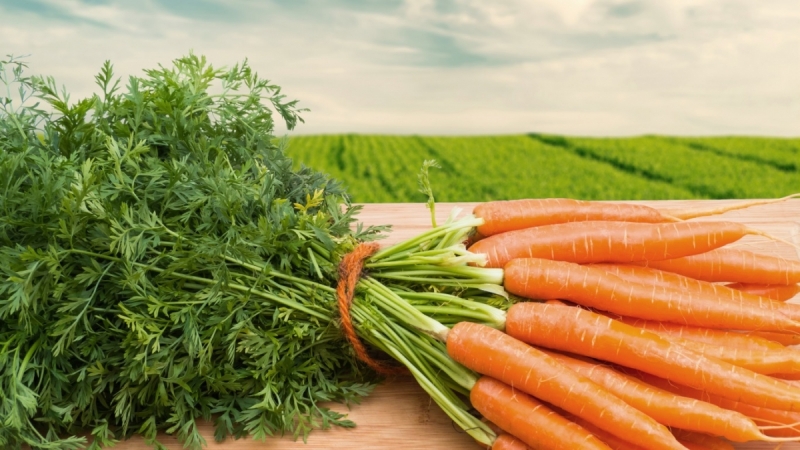
Calorie content - 35 kcal. The glycemic index is 35 for raw and 85 for boiled.
100 g of the product contains:
- proteins - 1.3 g;
- fats - 0.1 g;
- carbohydrates - 6.9 g;
- dietary fiber - 2.4 g
Carrot rich in vitamins. For example, it contains 11% of the daily intake of vitamin K, which regulates blood clotting.
Important! 100 g of the root vegetable contains a double daily rate of beta-carotene. In the body, it is converted to vitamin A, which improves vision and skin, supports immunity, and is responsible for reproductive function.
Salads and casseroles are made from carrots; they are boiled, stewed, pickled.
Low GI raw carrots are considered a suitable dietary food.
Sweet potato or sweet potato
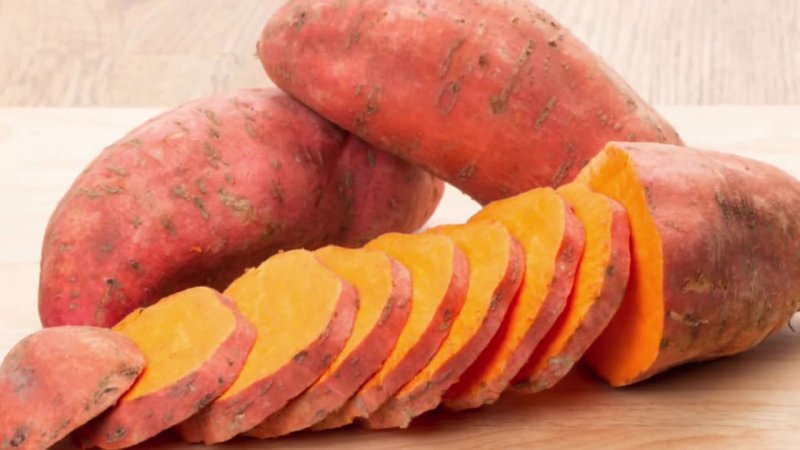
The chemical composition is close to potatoes. The glycemic index is 44 for boiled in a peel and 90 for peeled and baked.
Sweet potato is useful with vitamins:
- A - 33.3% of the daily value in 100 g of the product;
- B5 - 16% (participates in protein and fat metabolism, hemoglobin synthesis);
- C - 25.6%.
There are many trace elements in the tuber:
- potassium - 15.9%;
- manganese - 12.9%;
- copper - 15.1%.
The peculiarity of sweet potato is a sufficient amount of valuable antioxidants (carotenoids, anthocyanins and phenolic acids).
When cooked, sweet potatoes taste like a pumpkin, and when raw, they look like carrots in color and taste. Can stay fresh for a long time thanks to protein. It is a part of soups, side dishes, casseroles are made from it.
Sweet potatoes are a worthy replacement for regular potatoes when cooked properly. Contains low GI carbohydrates to help you satiate quickly and reduce appetite. Insoluble fiber cleanses the intestines.
Cauliflower
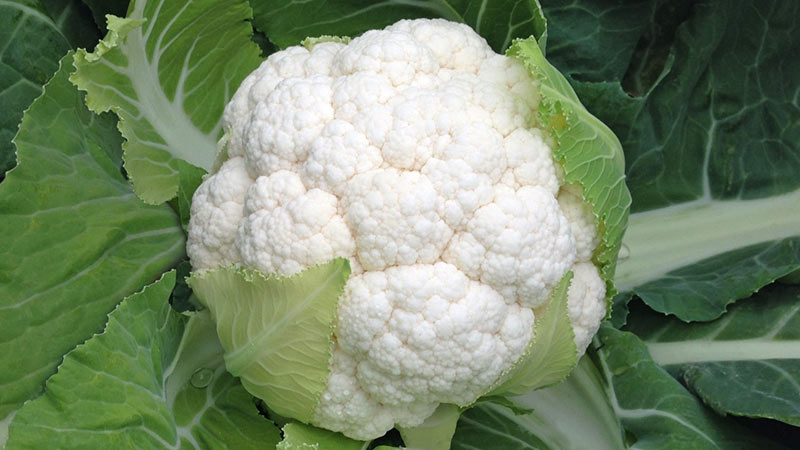
In terms of calorie content, the amount of proteins and fats, it is similar to potatoes. Contains four times less carbohydrates. The glycemic index is 15.
Cauliflower is useful with vitamins that make up its composition:
- C - 80% of the daily value in 100 g;
- K - 13% (regulates blood clotting);
- B6 - 10%.
It is digested better than white cabbage. Fiber practically does not irritate the walls of the stomach and cleanses the intestines well.
Cauliflower is a popular and delicious dietary product. It is boiled, fried, baked.
Legumes
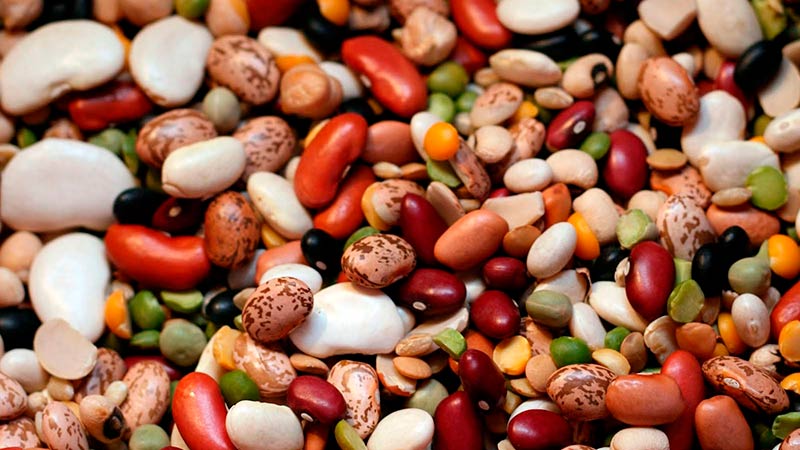
The main representative is beans.
Calorie content - 297 kcal. 100 g of the product contains:
- proteins - 21.0 g;
- fats - 2.0 g;
- carbohydrates - 47 g;
- dietary fiber - 12.4 g
The glycemic index for white beans is 35, for red beans - 27, for green beans - 15.
Attention! Fiber in 100 g of beans is 60% of the daily value.
There are a lot of beans in:
- vitamin B1 - 33.3% of the norm;
- B5 - 45%;
- B6 - 45%;
- B9-23%;
- PP - 32%.
Trace elements:
- potassium - 44%;
- manganese - 67%;
- phosphorus - 60%;
- iron - 32.6%;
- selenium - 45%.
In taste and type of dishes, beans are close to potatoes, and in their nutritional value they are in many ways superior.
Beans are an ideal substitute for potatoes. It is put in soups, salads, served as a side dish.
Other legumes (soybeans, peas, lentils) are not as versatile as potatoes or beans, although they are also used for a variety of dishes.
Conclusion
Potatoes cooked in their skins are considered a good dietary product due to their low calorie content, medium GI and the presence of plant fibers. However, when cooked in other ways, it loses its beneficial properties.
Other vegetables with their own set of useful nutrients - celery, daikon, rutabaga, turnip, kohlrabi, Jerusalem artichoke, carrots, sweet potatoes, cauliflower, and legumes - may well become a substitute for potatoes during a diet. A variety of foods will only benefit the body.